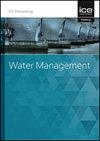边界条件对管道压力波反射模拟的影响
IF 1.1
4区 工程技术
Q3 ENGINEERING, CIVIL
Proceedings of the Institution of Civil Engineers-Water Management
Pub Date : 2022-10-24
DOI:10.1680/jwama.21.00126
引用次数: 0
摘要
在以往的文献中,水压实验中压力波的流动特性表明,反射波有两种类型:相同压力振动趋势型和相反振动趋势型,其压力幅值与原波相同。模拟中的反射特性必须与实验中的反射特性一致。为了确定合理的边界条件,本文采用计算流体力学(CFD)方法对五种边界条件组合下的压力波反射进行了模拟。基于k-ε湍流模型建立了三个三维模拟模型。得到了不同边界下的反射特性。结果表明,管道内的压力边界可以正确地得到反射波。储层比压力边界更精确,可以反映反射波的轻微波动。壁面边界和速度边界都可以用来模拟阀门的运行。然而,如果以截流管道的一部分为目标,反射波与原管道相同位置的反射波相比,会出现相位超前和压力幅值衰减。本文有助于压力波模拟中边界的合理设置。本文章由计算机程序翻译,如有差异,请以英文原文为准。
The Influence of Boundary Conditions on Pressure Wave Reflection Simulation at Pipe
In previous literature, the flow characteristics of pressure waves in hydraulic experiments have demonstrated that there are two types of reflected waves: the same pressure vibration trend type and the opposite vibration trend type, with the equal pressure amplitude as the original wave. The reflection characteristics in the simulation must be consistent with those in the experiment. To determine reasonable boundary conditions, this paper focused on the simulation of pressure waves reflection under five combinations of boundary conditions using the computational fluid dynamics (CFD) method. Three three-dimensional simulation models were developed based on the k-ε turbulence model. Reflection characteristics were obtained under different boundaries. The result shows that the pressure boundary in the pipe could get reflected waves correctly. Reservoir is considered more accurate than the pressure boundary, which can reflect the slight fluctuation of the reflected wave. Both the wall boundary and the velocity boundary could be used to simulate the operation of the valve. However, if intercepting a part of the pipeline as objective, the reflected wave shows phase advance and pressure amplitude attenuation compared with that at the same position in the original pipeline. This paper is helpful for setting reasonable boundaries in pressure wave simulation.
求助全文
通过发布文献求助,成功后即可免费获取论文全文。
去求助
来源期刊
CiteScore
2.10
自引率
0.00%
发文量
28
审稿时长
6-12 weeks
期刊介绍:
Water Management publishes papers on all aspects of water treatment, water supply, river, wetland and catchment management, inland waterways and urban regeneration.
Topics covered: applied fluid dynamics and water (including supply, treatment and sewerage) and river engineering; together with the increasingly important fields of wetland and catchment management, groundwater and contaminated land, waterfront development and urban regeneration. The scope also covers hydroinformatics tools, risk and uncertainty methods, as well as environmental, social and economic issues relating to sustainable development.

 求助内容:
求助内容: 应助结果提醒方式:
应助结果提醒方式:


